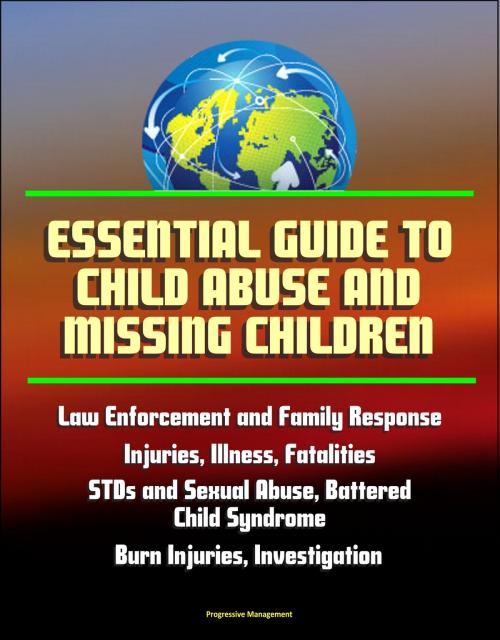Essential Guide to Child Abuse and Missing Children: Law Enforcement and Family Response, Injuries, Illness, Fatalities, STDs and Sexual Abuse, Battered Child Syndrome, Burn Injuries, AMBER Alert
Nonfiction, Family & Relationships, Family Relationships, Abuse, Social & Cultural Studies, Social Science| Author: | Progressive Management | ISBN: | 9781311226266 |
| Publisher: | Progressive Management | Publication: | February 21, 2015 |
| Imprint: | Smashwords Edition | Language: | English |
| Author: | Progressive Management |
| ISBN: | 9781311226266 |
| Publisher: | Progressive Management |
| Publication: | February 21, 2015 |
| Imprint: | Smashwords Edition |
| Language: | English |
This professionally-formatted free-flowing ebook compilation reproduces official documents about child abuse and missing children. Contents include: Portable Guide To Investigating Child Abuse - Law Enforcement Response to Child Abuse * Recognizing When a Child's Injury or Illness Is Caused by Abuse * When Your Child Is Missing: A Family Survival Guide * The Crime of Family Abduction - A Child's and Parent's Perspective * Investigating Child Fatalities * Sexually Transmitted Diseases and Child Sexual Abuse * Battered Child Syndrome: Investigating Physical Abuse and Homicide * Burn Injuries in Child Abuse * Law Enforcement Response to Child Abuse * Diagnostic Imaging of Child Abuse * Forming a Multidisciplinary Team To Investigate Child Abuse.
Law Enforcement Response - Child abuse is a community problem. No single agency has the training, manpower, resources, or legal mandate to intervene effectively in child abuse cases. No one agency has the sole responsibility for dealing with abused children. When a child is physically assaulted or sexually abused, the ideal response is for doctors to treat injuries, therapists to counsel the child, social services professionals to work with the family, law enforcement officers to arrest the offender, and attorneys to prosecute the case. This is possible only if the agencies and organizations involved have an established process for working together to respond to child abuse cases. The most effective community response involves establishing a child protection team that includes professionals from the medical, mental health, criminal justice, social services, and education fields who understand and appreciate the different roles, responsibilities, strengths, and weaknesses of the other team members and can cooperate and coordinate their efforts. Law enforcement's role in child abuse cases cannot be overstated. It spans the entire case from the initial call, through the investigation, to the court proceedings. Law enforcement officers investigate and determine if a criminal law has been violated; identify and apprehend the offender; file appropriate criminal charges; and provide guidance and support to the child, family, and other agencies involved. Law enforcement's response needs to be constant and consistent. This guide provides the information officers need to ensure consistency, understand their importance as vital members of the multidisciplinary team, and recognize the value of effective procedures and protocols in guiding their work with other professionals to meet the needs of abused children.
Each year, nearly 1.3 million children are reported missing. Although the unforeseen absence of a child is always upsetting, fortunately most missing children are returned home in a short period of time. This fact, however, provides little consolation for the parents of children whose whereabouts and welfare remain unknown. The Guide provides helpful advice for parents whose children are missing and also offers encouragement and support.
Investigators should have a working knowledge of battered child syndrome and what it means to an investigation. Battered child syndrome is defined as the collection of injuries sustained by a child as a result of repeated mistreatment or beating. If a child's injuries indicate intentional trauma or appear to be more severe than could reasonably be expected to result from an accident, battered child syndrome should be suspected. In such cases, an investigator must do more than collect information about the currently reported injury. A full investigation requires interviewing possible witnesses about other injuries that the child may have suffered, obtaining the caretakers' explanation for those injuries, and assessing the conclusions of medical personnel who may have seen the victim before.
This professionally-formatted free-flowing ebook compilation reproduces official documents about child abuse and missing children. Contents include: Portable Guide To Investigating Child Abuse - Law Enforcement Response to Child Abuse * Recognizing When a Child's Injury or Illness Is Caused by Abuse * When Your Child Is Missing: A Family Survival Guide * The Crime of Family Abduction - A Child's and Parent's Perspective * Investigating Child Fatalities * Sexually Transmitted Diseases and Child Sexual Abuse * Battered Child Syndrome: Investigating Physical Abuse and Homicide * Burn Injuries in Child Abuse * Law Enforcement Response to Child Abuse * Diagnostic Imaging of Child Abuse * Forming a Multidisciplinary Team To Investigate Child Abuse.
Law Enforcement Response - Child abuse is a community problem. No single agency has the training, manpower, resources, or legal mandate to intervene effectively in child abuse cases. No one agency has the sole responsibility for dealing with abused children. When a child is physically assaulted or sexually abused, the ideal response is for doctors to treat injuries, therapists to counsel the child, social services professionals to work with the family, law enforcement officers to arrest the offender, and attorneys to prosecute the case. This is possible only if the agencies and organizations involved have an established process for working together to respond to child abuse cases. The most effective community response involves establishing a child protection team that includes professionals from the medical, mental health, criminal justice, social services, and education fields who understand and appreciate the different roles, responsibilities, strengths, and weaknesses of the other team members and can cooperate and coordinate their efforts. Law enforcement's role in child abuse cases cannot be overstated. It spans the entire case from the initial call, through the investigation, to the court proceedings. Law enforcement officers investigate and determine if a criminal law has been violated; identify and apprehend the offender; file appropriate criminal charges; and provide guidance and support to the child, family, and other agencies involved. Law enforcement's response needs to be constant and consistent. This guide provides the information officers need to ensure consistency, understand their importance as vital members of the multidisciplinary team, and recognize the value of effective procedures and protocols in guiding their work with other professionals to meet the needs of abused children.
Each year, nearly 1.3 million children are reported missing. Although the unforeseen absence of a child is always upsetting, fortunately most missing children are returned home in a short period of time. This fact, however, provides little consolation for the parents of children whose whereabouts and welfare remain unknown. The Guide provides helpful advice for parents whose children are missing and also offers encouragement and support.
Investigators should have a working knowledge of battered child syndrome and what it means to an investigation. Battered child syndrome is defined as the collection of injuries sustained by a child as a result of repeated mistreatment or beating. If a child's injuries indicate intentional trauma or appear to be more severe than could reasonably be expected to result from an accident, battered child syndrome should be suspected. In such cases, an investigator must do more than collect information about the currently reported injury. A full investigation requires interviewing possible witnesses about other injuries that the child may have suffered, obtaining the caretakers' explanation for those injuries, and assessing the conclusions of medical personnel who may have seen the victim before.















